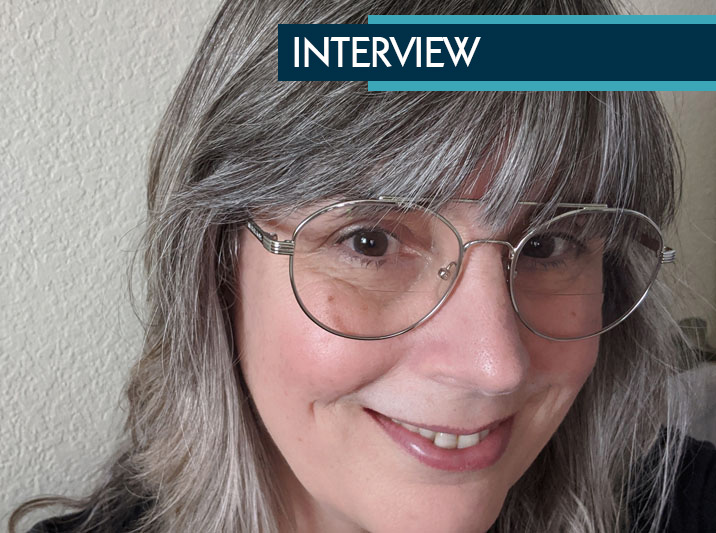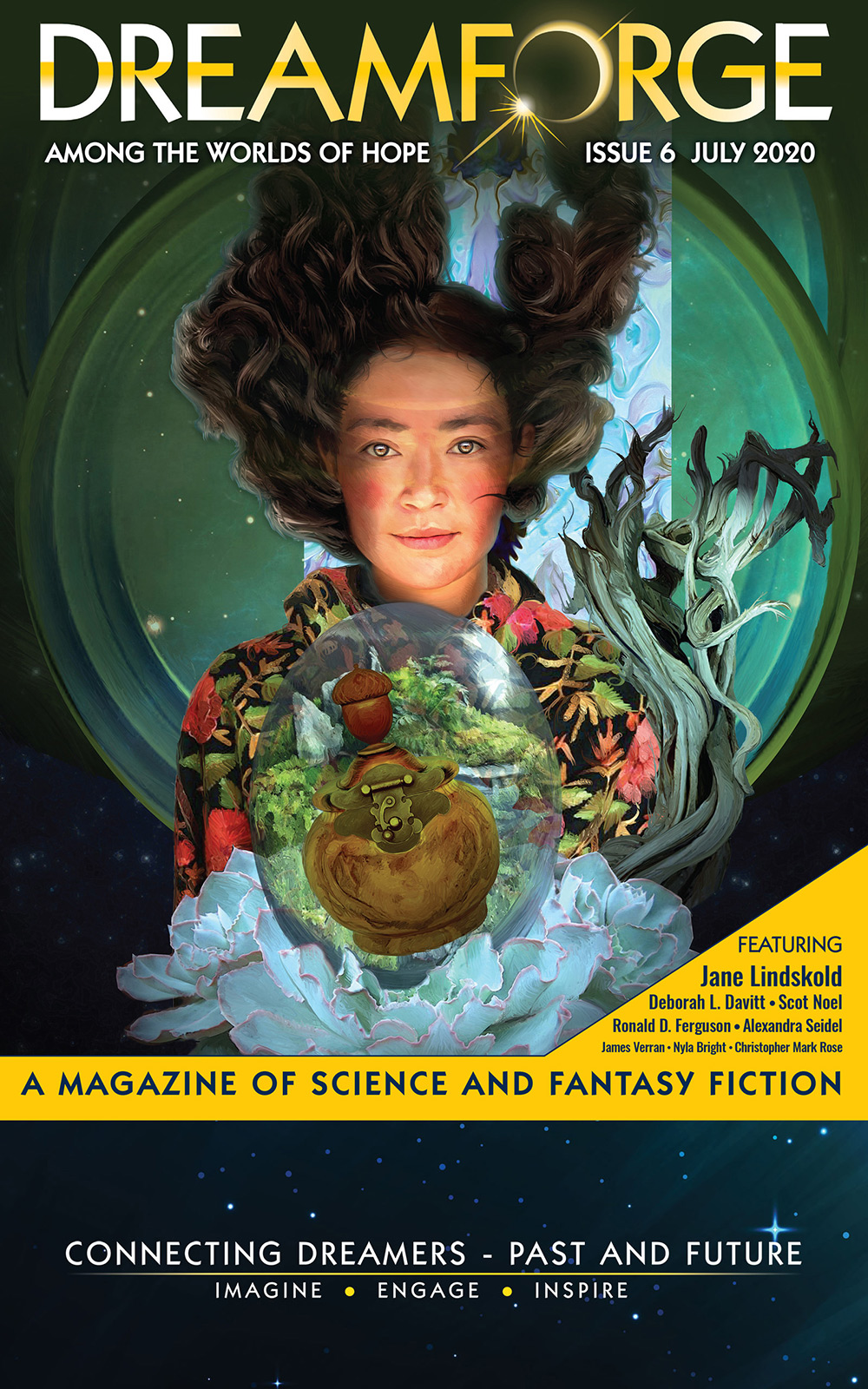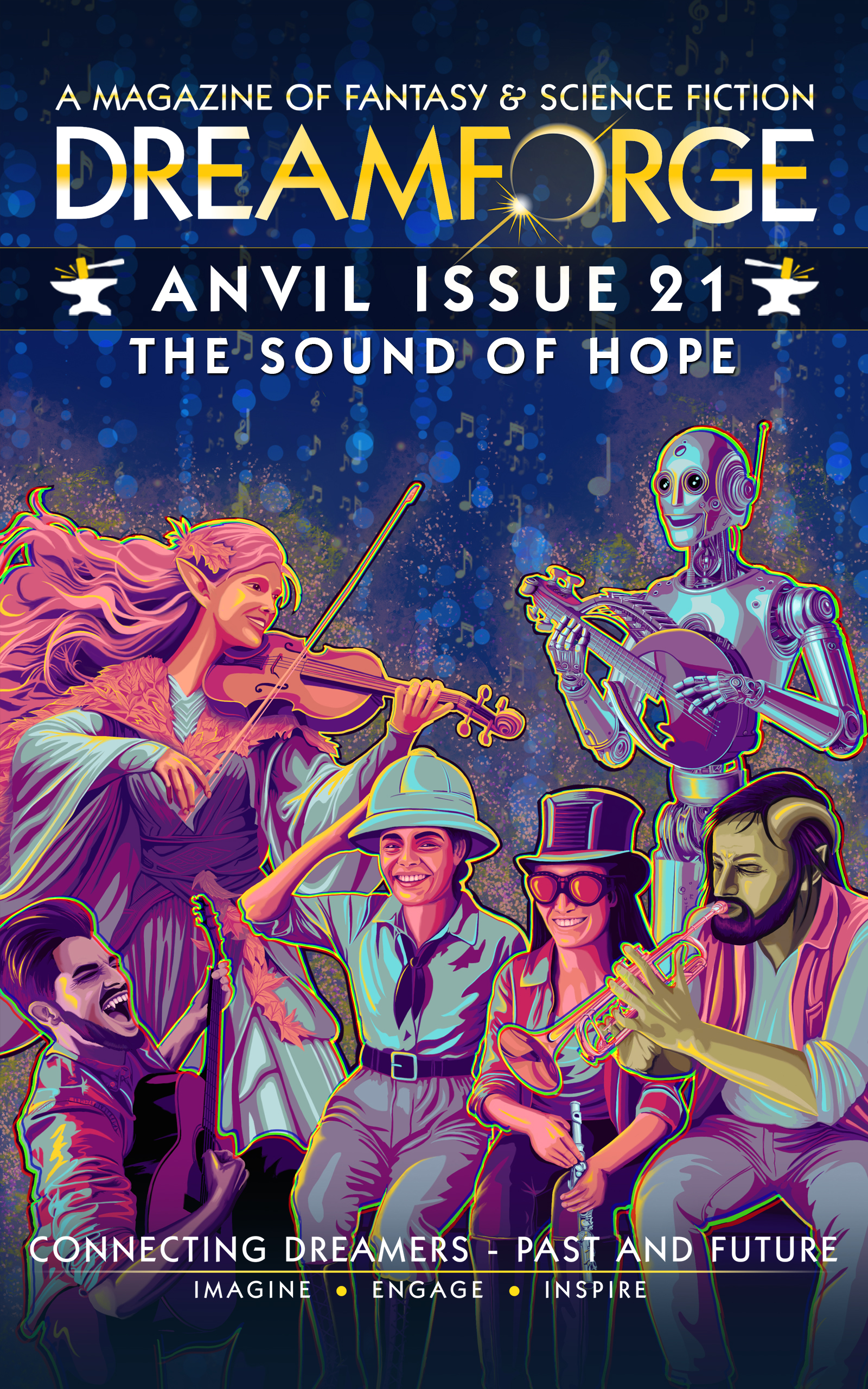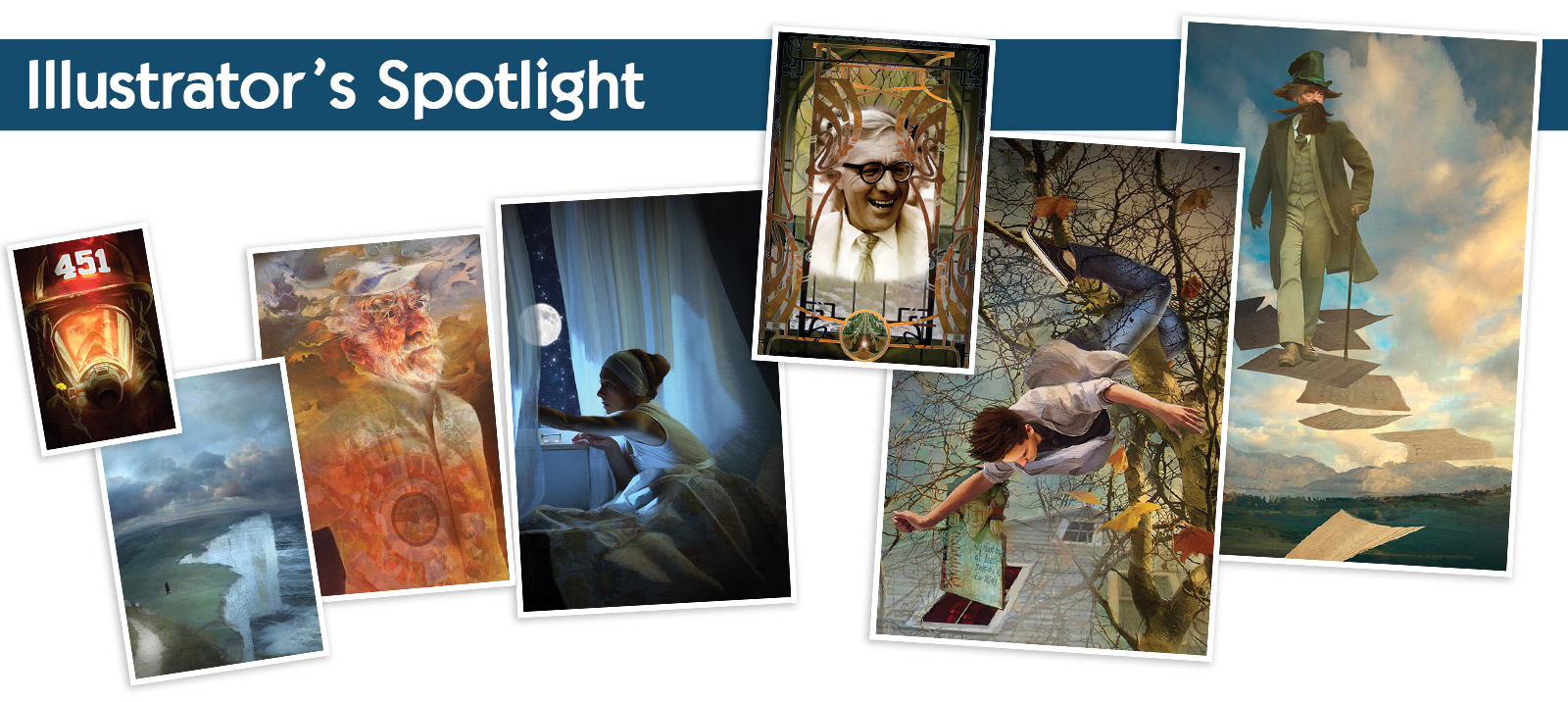
Elizabeth Leggett is a Hugo award-winning illustrator whose work focuses on soulful, human moments-in-time that combine ambiguous interpretation and curiosity with realism. Her clients represent a broad range of outlets, from multiple Hugo award winning Lightspeed Magazine to multiple Lambda Literary winner, Lethe Press. She was honored to be chosen to art direct both Women Destroy Fantasy and Queers Destroy Science Fiction, both under the Lightspeed banner.
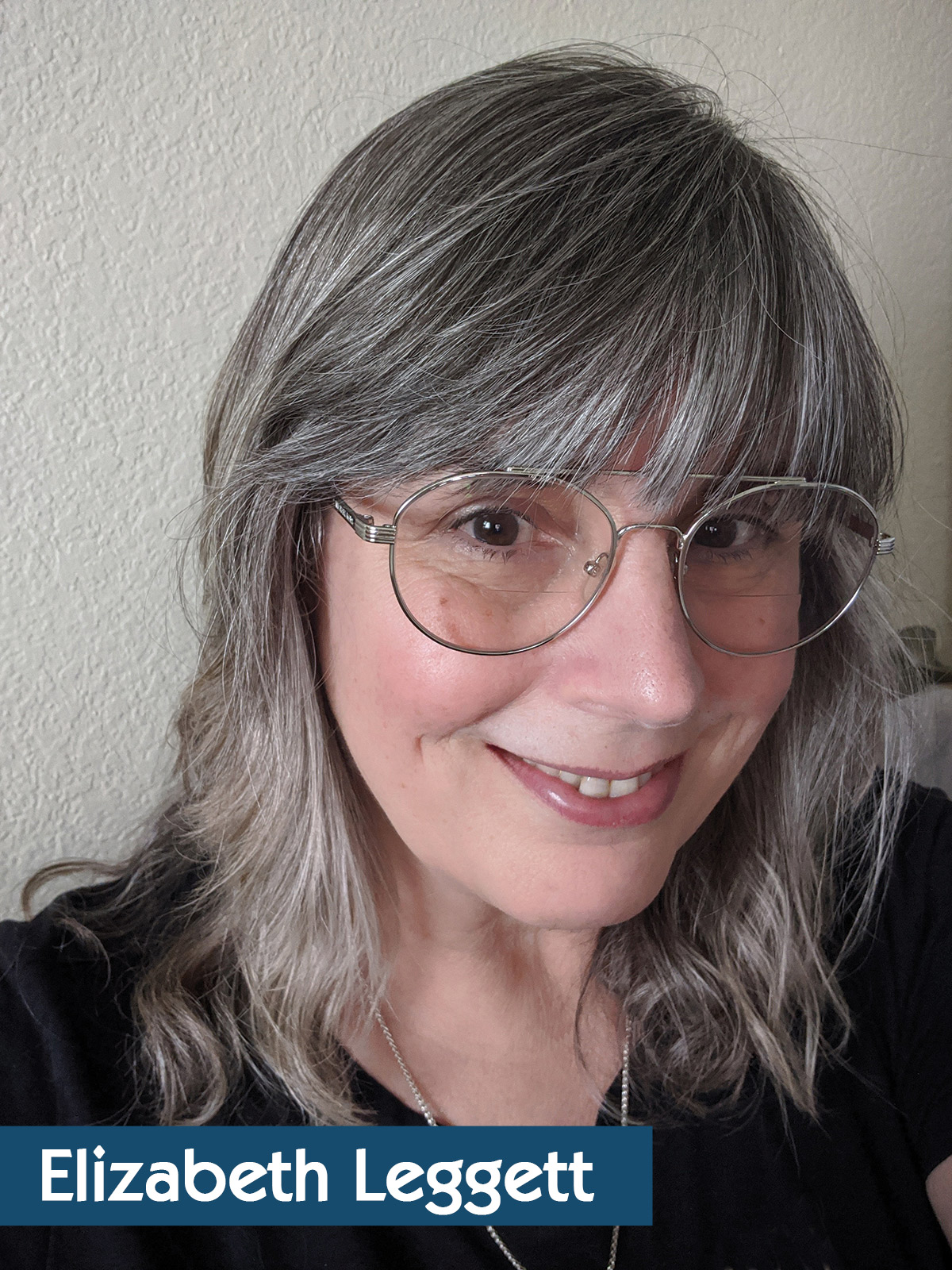
And, of course, Elizabeth has contributed work to every DreamForge issue, and takes the cover for Issue 6: Among the Worlds of Hope
QUESTION:
For Issue 6, instead of using one of our best pieces of story art for the cover, we asked you to create a cover and we would write a story to go with it. You chose a composition based on the Pandora’s Box mythology. That makes sense for a magazine with a core theme of hope, but I was intrigued by the serene, confident look of your modern Pandora. Whatever is happening to her in that moment – she’s got this. That’s definitely going to help shape the story.
Based on what I’ve seen of your art, you have an affinity for portraying women as poised and confident. Can you speak to that?
ANSWER:
I believe we bring to our viewing of art our own lives, our own conceits. For me, I believe humanity is not found in perfection, but more readily seen in a striving toward something greater. For the cover piece, I wanted to show that the tragedy that began Pandora’s story did not end there for her or for us. We are more compassionate when we know the world does not exist without sadness or mistakes. We grieve, we consider, and we move forward. Keeping hope becomes sacred progress.
As for the women in my work, I try to portray personalities rather than just objects of beauty. There is nothing wrong with the latter, but I learn more from the former. I think we as artists and writers learn quite a bit from our creations about ourselves.
QUESTION:
For me, all of your pieces tell a story. None are solely based on light, composition, or emphasizing a particular technique. They embody narrative. I know you are a fantasy writer too. Are you writing stories in your head when you create an illustration?
ANSWER:
Oh my goodness, so many stories!
There is something of a relationship you begin to have when you spend hours and hours staring at the same piece of work. For me, it starts out as a plot of what happened right before this moment and what may happen right after. I find myself putting in symbols and tiny hints to the stories into the piece as if the viewer could hear the story, too. However, I now realize that the viewer brings their own narratives and sometimes those are a lot more interesting than mine! I LOVE hearing their ideas. It makes each piece a secret to be discovered later. It makes me smile just thinking about that!
QUESTION:
When you create your art, what are your references? Do you work with models, stock images, or take inspiration from past masters?
ANSWER:
I like to use real people as much as possible. I have a few regular models including the young woman that looks after our cats when we are away and a geophysicist that lives about an hour away. She has been the model for a large number of my pieces that required a full body frame. My maternal grandmother was the basis for my high priestess for the Ray Bradbury major arcana exhibit.
Stock images help with hands and body positioning, but the best are the dedicated artist reference photos. Also, never underestimate the usefulness of pause during a show! Those moments can make the best reference sketches!
QUESTION:
Two of your major projects have been related to Tarot. In 2015, you created a full deck of 78 digital paintings to create the Portico Tarot Art Print Collection, a project that took over a year of dedication. This year, you returned to that theme by producing a full set of 22 Major Arcana illustrations based in the works of Ray Bradbury. The first project is a powerhouse of nice pieces; the second is simply breathtaking. What draws you to the Tarot for inspiration?
ANSWER:
Neither deck began as an intentional tarot project. The first was what I call my “accidental” deck. For three years prior, I had done no art work at all to speak of. There were maybe six pieces created that whole time. When that ended, I couldn’t NOT create. It was a huge driving force. I had done four pieces in a row in a very short amount of time and was desperate for a new subject. I called a friend and she asked if I had a tarot deck. I had purchased Stephanie Law’s Shadowscape deck a few years before because the art is stunning and so I said yes. My friend said I should draw the fool card; this manic art drive will pass. It didn’t. The next day, I drew randomly and used my friend as the model. This went on and on. As I was certain it was going to stop, I used my friends and family in the cards.
This was never going to be a finished project, I told myself. Clearly, I was wrong about that! ~laughs ~ I decided that I wanted to see the cards as cards. I set up a Kickstarter, it funded in six hours and it paid for my wedding!
The second tarot project was the result of taking the right class at the right time. There is a lot about being a professional artist that is not taught in school. Lauren Panepinto and Marc Scheff created a business course webpage for artists called Drawn and Drafted. They have courses under “Make Your Art Work.” One of those was “The Art of the Pitch” with Mallory O’Meara. It was focused on how to create a pitch for a project, how to find your audience to present it, and how to ask questions when there might be an opportunity for something opening up.
I had been showing at KEEP Contemporary Gallery in Santa Fe for a little over a year at that point. I had gone in to replace some art that had been sold. The gallery owner briefly mentioned that he was trying to figure out his 2019 gallery showing schedule. I realized this was one of those moments my course had mentioned so I asked if he had anything booked for October. Since October is high tourist season due to the balloon festival, I had expected him to say that was already assigned.
He said, “Nope. You want it?”
“Uh yes,” I said. I mean, what else could I say?!
“So what is your theme?”
‘Um, I will tell you tomorrow!”
I drove home and had nothing. No ideas at all for a decent theme. When I got home, I went to my bookshelf. I have been carrying around the same copy of Ray Bradbury’s “I Sing The Body Electric” since high school. It is a mess of underlined quotes and side notes and bad teenage poetry. I have used it for years for art prompts. I decided it could do that again.
I called my gallery owner and told him I wanted to do a Ray Bradbury themed show.
He asked, who is Ray Bradbury?
I told him and he seemed interested, but he said it was an October show. I needed to find a way to work that in. It needed a supernatural/ spooky bent. The show was later named READINGS because the images are based on short stories by Ray Bradbury, but also because of fortune telling spreads. So THAT is how it was connected with tarot!
QUESTION:
What is your method of creation? Is your work completely digital? Do you sketch your ideas out beforehand? At DreamForge, we’ve noticed that preliminary mockups are not your thing; you often go from an idea we’ve talked about to a finished piece with no intermediary steps. How does the experience go for you when you’re working on assignments for us and other magazines?
ANSWER:
I have a number of clients and each need different things for communication. Sometimes an art director needs to show my ideas to an outside party and so I do black and white mockups that leave little to imagination. It helps the AD build confidence with their client.
Sometimes, rough sketch work is enough for communication, but it really has to be with someone that can genuinely see where this image is going. Usually, that is an artist to artist thing.
For you guys, I rather like giving you full work because I know if it doesn’t work for you, you will let me know. It doesn’t bother me to start again for you. Usually, if it needs to be changed, it makes perfect sense. I guess I trust you guys!
QUESTION:
Who influences you? What illustrators do you follow in order to find inspiration?
ANSWER:
Oh…long list.
- Laurie Brom
- N.C. Wyeth
- Mark Harrison
- Micheal Kaluta
- Colin and Kristine Poole
- Red Nose Studios
- Gustav Klimt
- Allen Williams
- Norman Rockwell
- Bertha Lum
- Nicholas Delort
- Stephanie Law
- Karla Ortiz
- Eric Velhagen
- Julie Dillon
and, and, and…
Truly, there are so many that it starts to get a bit out of hand. ~laughs ~
QUESTION:
What’s the most challenging thing for you to undertake in your art? Where do you find that, to get the results you want, you need to push yourself to new heights?
ANSWER:
My biggest challenge has always been overthinking. I am pretty sure a lot of other artists and writers battle that demon as well. If I am really focused into a particular piece, every color choice, every texture change has been considered and reconsidered ad nauseum. Please pity my husband. He has to listen to me babble when that is happening!
QUESTION:
How has your style changed over the years? Have you gravitated toward a particular strength? What weakness have you worked hardest to shore up?
ANSWER:
Of course! However, when you are working in it, it is sometimes hard to see until there is a reason to look back. When I did the first tarot deck, all of my textures were swirls and waves. They felt more like texturalized quilts. Now, I am significantly more linear, but I know when I am getting tired because I get swirl-y again and my brush sizes go up. I think this may be because my eyes get tired before I realize that is what is going on.
I think I have a couple of strengths. I prefer to create people that look like you could have a conversation with them rather than unapproachable models. I think that is better storytelling. I did family portrait work for a number of years and that skill set has gotten more hours than others. My second major strength is adding symbolism/story telling elements to a piece. If it is not for a contract, I tend to stuff an image with pieces that match the narrative in my head. I love when people ask about this or that and then smile! They have a secret knowledge of the piece that they then can share.
Weaknesses: The biggest is not knowing what I don’t know until I am face to face with it. When that happens, sometimes there is a struggle of confidence. I want to force an image into something more familiar rather than take on something new to me. There is a fair amount of growling and snarling and “I don’t wanna!” before I settle back down and tackle the problem. I think we all have things that bring out the little stubborn kid in ourselves!
QUESTION:
What advice would you give to beginning illustrators in finding and building a client list? Is it all about word-of-mouth? Displaying at conventions? Building an online portfolio? Contacting potential clients directly?
ANSWER:
First and foremost, have an unforgiving and merciless conversation with yourself and lay out what you really, really want, but more importantly, what you NEED. Do you want this to be a job or a hobby that sometimes makes money? How much money do you need to live in a manner you require? What are your life priorities? The list goes on, but that is where an artist should start. We all have a dreamy-happy space image of being an artist, but it is one dimensional and like any plan, does not survive contact with the enemy. The enemy in this case is not being honest with yourself about what life you genuinely want.
Okay, so after that’s addressed, decide what are you want to do and seek out artists and businesses that are doing that work. For those in my genre, I recommend checking out muddycolors.com. It is a huge wealth of information and you will find a bunch of people that are in the business of art.
Conventions are great ways to get a lot of eyes on your work and build a fan base, but yes, you are going to need an online portfolio or website as well because you want to “continue the conversation” as it were with those people after the convention is over.
As far as client contacts, there are many, many ways to do that. It really depends on what your goals are. Again, go find folks doing what you want to do and they will have the best answers for you.
QUESTION:
We realize we’re putting you on the spot a bit, but we’re very grateful for all you’ve done for DreamForge Magazine. How do you think we’ve done artistically with the magazine in general, in choosing art and in our graphic design and layout?
ANSWER:
I LOVE DreamForge. You guys had my heart at Hope Punk. The magazine is just what the world needs right now…a glimpse into a world that is trying to be better. You are giving new artists and brilliant writers a place to shine. The layout is fresh and professional, the stories are compelling. You guys hit it out of the park with this dream and we are lucky enough to get to see it, too!
QUESTION:
Is there any project you have underway that you would like to tell our audience about? What are you hopeful for in the coming years?
ANSWER:
Shhhh! That would spoil the surprise!


